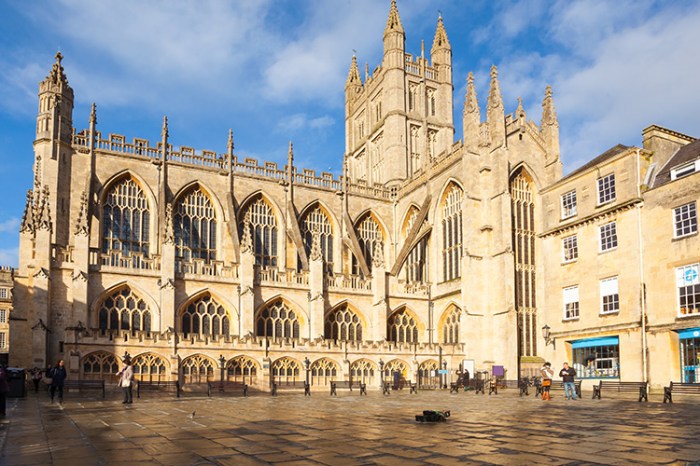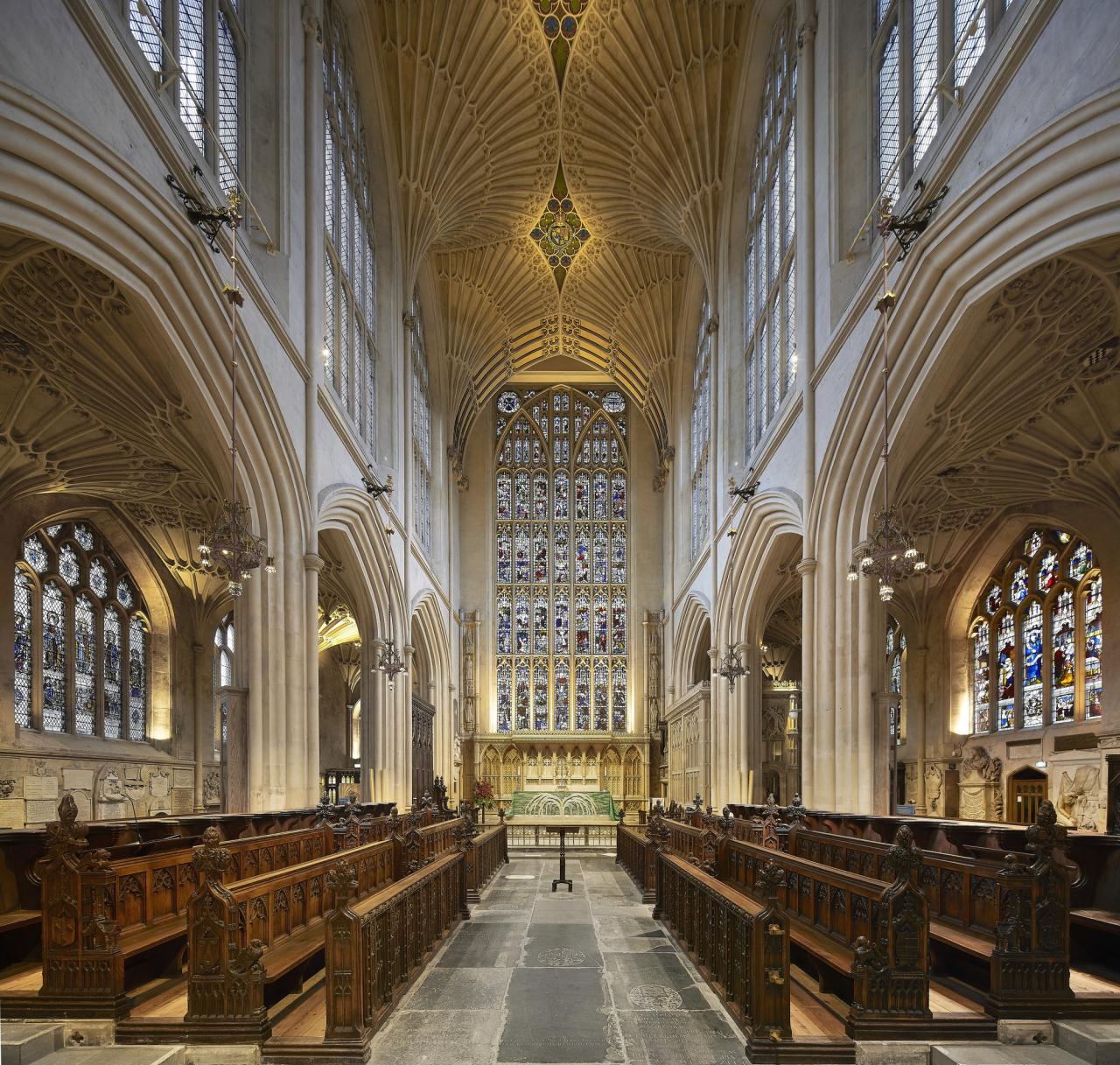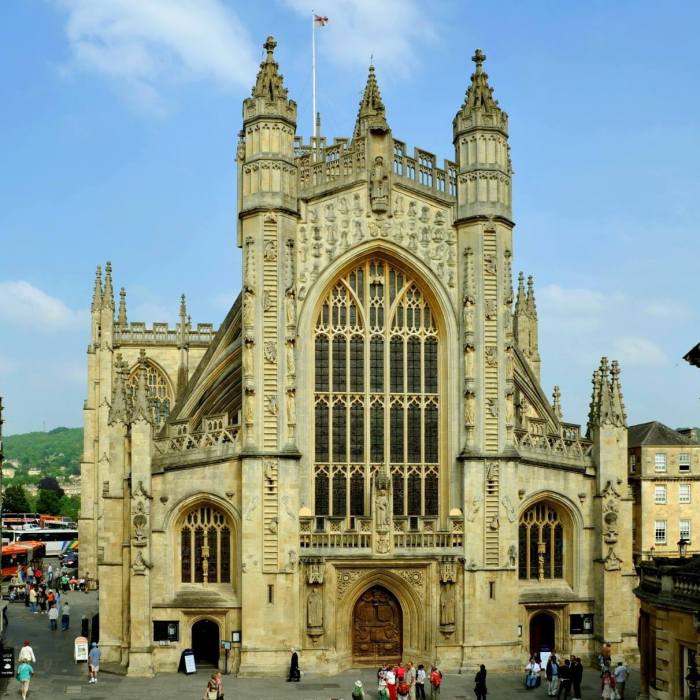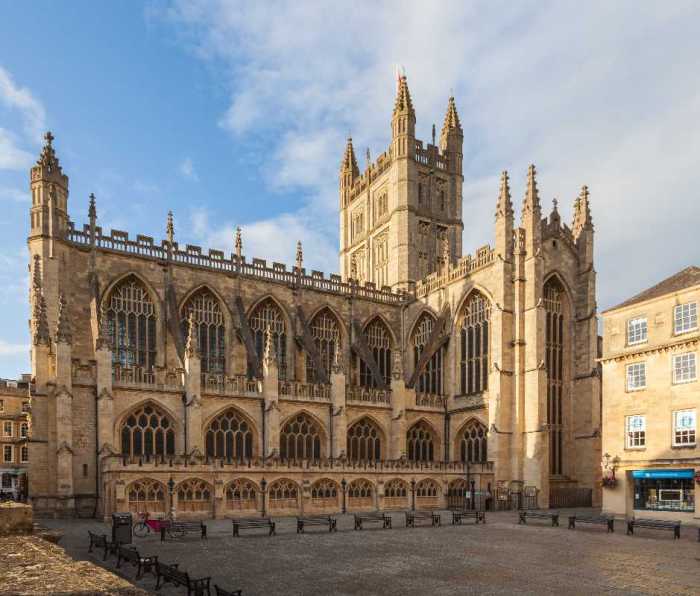Nestled amidst the picturesque city of Bath, Bath Abbey stands as a testament to centuries of history, architectural grandeur, and religious significance. This magnificent edifice has played a pivotal role in shaping the cultural and spiritual landscape of the region, leaving an enduring legacy that continues to captivate visitors to this day.
From its humble beginnings as a Saxon monastery to its transformation into a magnificent Gothic cathedral, Bath Abbey has witnessed countless historical events and played host to notable figures throughout the ages. Its stunning fan vaulting, intricate stained glass windows, and rich symbolism invite exploration and inspire awe.
Historical Significance
Bath Abbey holds immense historical significance, rooted in its ancient origins and profound connection with the city of Bath. Its establishment in the 7th century marked a pivotal moment in the region’s religious and architectural landscape.
The abbey’s architectural evolution spans centuries, reflecting the changing tastes and advancements in ecclesiastical design. Notable historical figures, including King Edgar and Bishop John of Tours, have left their mark on the abbey’s history, contributing to its rich heritage.
Architectural Evolution
Bath Abbey’s architectural journey began in the 7th century with a modest wooden structure. Over time, it underwent significant transformations, showcasing various architectural styles.
- Saxon Period (7th-11th Century): The abbey’s earliest form was a simple wooden structure, reflecting the architectural norms of the Saxon era.
- Norman Period (11th-12th Century): Following the Norman Conquest, the abbey was rebuilt in the Norman style, featuring characteristic rounded arches and thick walls.
- Gothic Period (12th-16th Century): The abbey underwent extensive renovations during the Gothic period, resulting in the addition of pointed arches, ribbed vaults, and intricate stained-glass windows.
- Restoration Period (19th Century): In the 19th century, the abbey underwent a major restoration under the direction of renowned architect Sir George Gilbert Scott. This restoration aimed to preserve the abbey’s medieval character while incorporating Victorian elements.
Architectural Features: Bath Abbey

Bath Abbey stands as a masterpiece of Perpendicular Gothic architecture, renowned for its exceptional fan vaulting. This intricate ceiling design features a series of interlocking ribs that create a web-like pattern, giving the impression of a celestial canopy.
The abbey’s stained glass windows are equally impressive, adorned with vibrant hues and intricate iconography. These windows depict biblical scenes, saints, and historical figures, symbolizing the abbey’s connection to the divine and its role as a spiritual center.
Bath Abbey, a stunning medieval masterpiece, captivates visitors with its intricate architecture. Its grandeur is a testament to the rich history of Bath. After exploring the abbey’s hallowed halls, why not escape to the vibrant shores of barcelona beach ?
Bask in the Mediterranean sun, stroll along the promenade, and immerse yourself in the lively atmosphere. Upon your return, Bath Abbey awaits, offering a serene sanctuary to reflect on your adventures.
Fan Vaulting
The fan vaulting of Bath Abbey is a testament to the architectural ingenuity of its builders. Each rib is meticulously carved and fitted together, creating a harmonious and visually stunning effect. The fan-shaped ribs spread out from the central bosses, resembling the ribs of an open fan.
Stained Glass Windows, Bath abbey
The stained glass windows of the abbey serve both an aesthetic and didactic purpose. They illustrate stories from the Bible, providing a visual narrative for the illiterate. The windows also depict the lives of saints and local benefactors, celebrating their contributions to the community.
Bath Abbey, with its breathtaking architecture and historical significance, is a must-see destination in the heart of England. After exploring the abbey’s captivating interiors, why not embark on a refreshing getaway to the sun-kissed shores of Airlie Beach ? Immerse yourself in the turquoise waters of the Whitsundays, snorkel amidst vibrant coral reefs, and soak up the idyllic ambiance of this tropical paradise.
Upon your return to Bath, delve deeper into the city’s rich heritage by visiting the Roman Baths, gaining insights into the ancient world that once flourished here.
Religious Significance

Bath Abbey has served as a center of religious worship and pilgrimage for centuries. Its origins lie in the 7th century, when King Osric of Hwicce founded a monastery on the site. The abbey grew in importance over the following centuries, becoming a major center of learning and spirituality in the region.
In the 10th century, the abbey was rebuilt by King Edgar the Peaceful, who dedicated it to Saint Peter and Saint Paul. The abbey continued to flourish under Norman rule, and in the 12th century, it was granted a royal charter by King Henry II. This charter confirmed the abbey’s status as a royal peculiar, meaning that it was directly subject to the authority of the king rather than the local bishop.
Pilgrimage Center
Bath Abbey became a popular pilgrimage destination in the Middle Ages, particularly after the discovery of the relics of Saint Edward the Martyr in the 12th century. Pilgrims from all over England and beyond flocked to the abbey to pray at the saint’s shrine. The abbey also became a center for the veneration of other saints, including Saint Dunstan and Saint Aldhelm.
Impact on the Religious Landscape
Bath Abbey has had a significant impact on the religious landscape of Bath and the surrounding region. The abbey has been a major center of Christian worship and pilgrimage for centuries, and it continues to play an important role in the religious life of the city. The abbey is also a popular tourist destination, and its unique architecture and history attract visitors from all over the world.
Cultural Heritage

Bath Abbey has played a pivotal role in shaping the cultural identity of Bath. Its imposing presence and architectural grandeur have made it an iconic landmark, attracting visitors from around the world. Beyond its religious significance, the abbey has also been a vibrant center for cultural activities, hosting concerts, exhibitions, and other events that have enriched the cultural landscape of the city.
Venue for Cultural Events
Bath Abbey’s vast interior and exceptional acoustics make it an ideal venue for a wide range of cultural events. The abbey regularly hosts concerts featuring renowned orchestras, choirs, and soloists, offering a diverse program of classical, contemporary, and choral music. In addition, the abbey has been the setting for art exhibitions, showcasing works by local and international artists. These exhibitions have ranged from traditional paintings and sculptures to innovative installations and interactive displays.
Tourism and Heritage

Bath Abbey is a major tourist attraction, drawing visitors from around the world to admire its architectural beauty and historical significance. The Abbey’s unique blend of Norman and Gothic architecture, as well as its association with significant historical figures such as King Edgar and Queen Anne, make it a popular destination for tourists interested in history, architecture, and culture.
Preservation and Promotion
To preserve and promote Bath Abbey’s heritage for future generations, several measures have been implemented. The Abbey is a Grade I listed building, which provides legal protection against unauthorized alterations or demolition. The Abbey’s fabric is regularly inspected and maintained, and restoration projects are undertaken as necessary to ensure its long-term preservation.
Additionally, the Abbey hosts a variety of events and activities throughout the year, including guided tours, concerts, exhibitions, and educational programs. These events help to raise awareness of the Abbey’s history and significance, and they also provide opportunities for visitors to engage with the Abbey’s heritage in a meaningful way.
Community Involvement

Bath Abbey is deeply involved in the local community, actively participating in outreach programs and charitable initiatives.
Bath Abbey, a magnificent historical landmark, stands as a testament to architectural brilliance. Its soaring ceilings and intricate carvings evoke a sense of awe and wonder. While in Bath, consider venturing to the aquarium baltimore for an unforgettable marine adventure.
Witness the vibrant underwater world come to life as you explore diverse exhibits showcasing the wonders of the ocean. Upon returning to Bath Abbey, immerse yourself once more in its captivating history and architectural splendor.
The abbey serves as a gathering place for community events and celebrations, fostering a sense of belonging and unity among the residents.
Outreach Programs
- The abbey offers support to local schools, providing educational resources and hosting workshops on history, architecture, and religious significance.
- It runs a food bank that provides essential supplies to those in need, addressing food insecurity within the community.
- The abbey organizes regular community events, such as concerts, exhibitions, and lectures, promoting cultural enrichment and engagement.
Charitable Initiatives
- The abbey supports various charities, including those focused on homelessness, poverty alleviation, and environmental protection.
- It provides financial assistance to local organizations working towards community development and social welfare.
- The abbey collaborates with other faith groups and community organizations to address pressing social issues and promote interfaith dialogue.
Comparative Analysis (Optional)
Bath Abbey stands as a testament to the architectural prowess and religious significance of its era. Comparing it to other notable cathedrals and religious structures provides insights into the shared and distinct characteristics that have shaped these sacred spaces and their impact on their respective communities.
One striking similarity between Bath Abbey and other grand cathedrals is their intricate Gothic architecture. The pointed arches, ribbed vaults, and stained glass windows that adorn Bath Abbey are also prevalent in structures like Westminster Abbey, Canterbury Cathedral, and Notre Dame de Paris. These architectural elements not only add to the aesthetic grandeur of these buildings but also reflect the shared religious beliefs and aspirations of the communities that built them.
Architectural Differences
Despite the shared Gothic influences, Bath Abbey exhibits certain architectural differences that set it apart from its counterparts. Unlike many cathedrals that feature a cruciform layout with a central tower, Bath Abbey has a more linear design with a prominent west front. This unique configuration may have been influenced by the abbey’s monastic origins and the need to accommodate a large congregation.
Historical Significance
Bath Abbey’s historical significance is closely intertwined with the development of the city of Bath itself. Founded as a Benedictine monastery in the 7th century, the abbey played a pivotal role in the religious and cultural life of the region. Over the centuries, it underwent numerous renovations and expansions, reflecting the changing needs of the community and the evolving architectural styles of the time.
Impact on Communities
The presence of Bath Abbey has had a profound impact on the community throughout its history. As a center of worship, it has provided spiritual guidance and a sense of belonging to generations of believers. The abbey’s architectural splendor and historical significance have also made it a popular tourist destination, attracting visitors from around the world. The revenue generated from tourism supports the preservation of the abbey and contributes to the local economy.
Final Conclusion
As a center of religious worship, pilgrimage, and cultural heritage, Bath Abbey remains a vibrant and active institution. Its outreach programs and charitable initiatives foster a sense of community, while its breathtaking architecture and captivating history continue to draw visitors from far and wide. Bath Abbey stands as a testament to the enduring power of faith, the beauty of human creativity, and the rich tapestry of history that has shaped our world.
Quick FAQs
When was Bath Abbey built?
The origins of Bath Abbey date back to the 7th century, but the current building was constructed primarily in the 12th and 16th centuries.
What is the architectural style of Bath Abbey?
Bath Abbey is an excellent example of Perpendicular Gothic architecture, known for its intricate fan vaulting and large, airy spaces.
Who is buried in Bath Abbey?
Bath Abbey is the burial place of several notable figures, including King Edgar the Peaceful and Queen Elfrida.